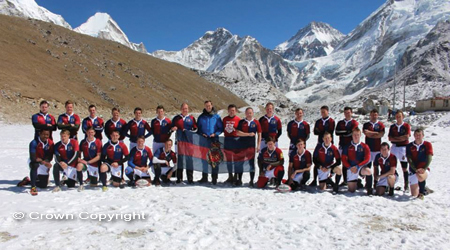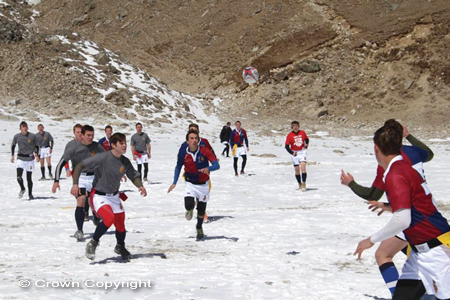|
TOUCH EVEREST
The Household Cavalry Expedition to Break
the Record for the Highest Game of Rugby in the World
by Captain M D de B Wilmot
The Blues and Royals
|

Touch Everest team members prior to kick off at Gorak Shep (5,165m) |
On 28th February 2014, 28 soldiers from the Household Cavalry Regiment, an even mix of Life Guards and Blues and Royals, set out for the Himalayas, in a bid to trek to Everest Base Camp and break a rugby world record.
The aim of the expedition, as written in 2012, was to allow soldiers from the Household Cavalry Regiment to conduct an arduous adventurous training exercise, testing their physical robustness, determination, and ability to work as a team in a non-military but competitive environment. Having recently returned from Op HERRICK 18, where the Household Cavalry Regiment provided the Brigade Reconnaissance Force, the Brigade Troops Echelon, and the ISTAR Group Headquarters, Touch Everest offered an excellent opportunity to provide our soldiers with a well earned break, maintaining a spirit of adventure but within a more relaxed, and much safer, environment to Afghanistan.
The expedition began with a 36 hour acclimatisation period in Kathmandu, which at 1,350 metres already sits higher than anywhere in the UK. This bought time for the expedition leaders to meet the Military Attaché and conduct routine in-country admin, whilst the remainder of the team had a tour of the cultural sights of the city. Our time in Kathmandu was intentionally short, and we made the 45 minute internal flight to Lukla in the early hours of day two. Lukla airport is steadfastly voted the most dangerous airport in the world and we were exceedingly lucky to get all 28 team members and our entire luggage over in one day, albeit across six different aircraft.
We made good pace in our first two days and arrived in Namche Bazaar on D+3. Namche is located within the Khumbu area at 3,440 metres (11,286 ft) at its low point, populating the sides of a hill. It is the main trading centre and tourist hub for the Khumbu and has a population of 1,647 people. This was a chance for the team to pick up any additional items of kit, as well as enjoy their last showers and flushing loos!
The next day we were presented with our first view of Mount Everest and the following four days offered near unbroken views of the highest point on earth. As the altitude increased so breathing got harder, our pace got slower and the evenings got much colder. Our accommodation each night was in Tea Houses, plywood buildings with basic gas cookers in the kitchens and thin mattresses for beds. Our sleeping bags had been sufficient in keeping us warm until around the 4,000m mark, after which any extra blankets were snapped up. Each morning we would wake up to frozen water bottles and the challenge of hastily getting dressed to minimize the time in the cold.
At Tengboche (3,867m) the team was unexpectedly hit with contagious D&V and our number was nearly halved to just 15. We split into two groups, the fitties and the sickies but by mid-morning the next day it was clear that it would be too dangerous to carry on. Those fit to continue made haste to our next stop, whilst those that were suffering from the virus remained behind with the Doctor. Overnight we lost a further four and all looked lost as a group of just 11 of us climbed to Nagarjun Hill at 5,000m. The resolve and determination of the Household Cavalryman showed its true colours, as all 28 were reunited in time to enjoy dinner together in Periche that night. Two days later every last man was involved in the rugby match, an extraordinary achievement considering our reduced numbers in the days running up to it.
The rugby was to be played at Gorak Shep, a dry flat lake bed at 5,165m, on the edge of the last permanent hamlet before Everest Base Camp. Capt Dean Owens, the Training Officer, is an IRB referee and would officiate the match. After marking out the pitch and having pre-match photos we kicked off for the first seven minute half of the tag rugby game. The match got off to a slow start as the players got used to playing at such high altitude, before LCpl Veramu of The Blues and Royals took an early interception and ran over half the length of the pitch to score the opening try. Bent double after his great sprint the already exhausted teams enjoyed the thirty second break to catch their breaths. The Life Guards took the kick off and Capt Johnny Clive of The Blues and Royals made an impressive run, breaking past two Life Guards players before Tpr Pringle tackled him just metres from the try line. The author, playing as scrum half, took a lucky break and managed to get the ball down to make it a 10-0 lead for The Blues and Royals. At half time, the team captains, Capt Johnny Clive (RHG/D) and Capt Alex Pickthall MC (LG), took a moment to inspire their teams and make changes from the bench. The second half was a much more fluid affair and, whist the score board remained unchanged, impressive runs from Capt Jack Barnes, LCoH Sabotini and Tpr Coventry made it a nail biting competition. There was unanimous relief, shortly followed by celebration, when the final whistle blew and the highest game of rugby ever played was complete.
Touch Everest proved to be both a challenging but hugely enjoyable expedition. In hindsight, we underestimated the task of getting such a large group of people to such a high altitude, and it was down to individual discipline and determination that we were able to achieve our aim of playing rugby above the 5,000m mark. It was a huge privilege to be part of something that will not be forgotten easily. Touch Everest demonstrated that ‘impossible is nothing’. Soldiers who had been tested to the limit on operations found themselves challenged, exercised and above all were given the opportunity to achieve great things that, were they not serving soldiers in the British Army, they would not have been a part of. I hope that this expedition sets a precedent for the scope of what can be achieved through Adventurous Training, particularly as we look ahead to an Army with changing commitments overseas.
 Touch Everest in full flow
Touch Everest in full flow |
|
|


